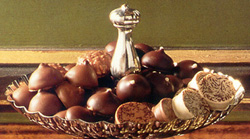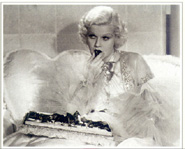






laptopcloseout.tripod.com
Laptops, Camcorders, Digital Cameras, PDAs. |
 |



|

|
A Love Affair with Chocolate
The Exquisite Mystery of Chocolate Bliss
It starts with a teasing coolness on the tongue. Then
the first bite begins to melt in your mouth, unfolding its warm glow
of flavors, both bitter and sweet, buttery and intense, with a hint of
vanilla and cinnamon and something else you can't quite describe. And
even after the last flavor subsides, the comforting feel of it lingers
on your taste buds, lush and smooth.
Cocoa contains more than 500 distinct flavor compounds making the
taste of chocolate a blend of flavors and aromas so complex that food
chemists have never been able to replicate it in the lab.1 It's melting point is 97 degrees Fahrenheit,
the exact temperature of the human mouth, so it melts immediately.
2 When taste buds begin to tingle with
the sensory delight of chocolate, the brain releases endorphins, the
body's feel good chemical.1 Chocolate
heightens energy and lifts the spirit.2
The ancient Maya called it the Food of the Gods.
The courtesans of Louis XV used it as an aphrodisiac. Chocolate is not
addictive but it can be a powerful mental stimulant. It contains
anandamide, a chemical also produced by nerves cells in the brain. The
anandamide in chocolate acts on the pleasure centers in the brain,
3 and mimics the psychoactive effects of
plant-derived cannabinoids,4
triggering euphoria. When people eat chocolate, the anandamide makes
them feel good,3 though its effects
are more subtle and longer lasting in chocolate.5
Chocolate also contains phenylethylamine, a
chemical released in the brain causing the mental arousal we feel when
we fall in love,2 perhaps equivalent
to orgasm. Scientific proof to what we had suspected all along:
chocolate spices up our love life. Montezuma would think so, he was
said to have drunk a golden goblet of cacao beverage prior to entering
his harem, where he encountered a new partner every night.
Medicinal Properties of Chocolate
Chocolate has been used as a medicinal remedy over the
years. It was also prescribed as medicine by the ancient Mayans and
Aztecs and a treatise recommended chocolate for many diseases, citing
it as a cure for Cardinal Richelieu's ills.4
Harvard researchers have found in a study that
people who eat chocolate live longer.6
They account their findings on the fact that chocolate is rich in
potent antioxidants called phenolics. Chocolate is a powerful
antioxidant for oxidation of low density lipoprotein (bad
cholesterol).1 It also contains
alpha-tocopherol (the most active form of vitamin E), another
antioxidant.7 Chocolate has been
proven to lower cholesterol levels.8
Therefore, eating chocolate lowers the risk of heart disease and
cancer.6
Chocolate provides nutrients necessary to
stabilize moods, control weight, and revitalize well-being. It
contains theobromine, which increases alertness, concentration and
cognitive functioning. It also contains magnesium, a mineral involved
in manufacturing the potent brain chemical called serotonin, which
makes us feel calm.2 And chocolate is
a major source of dietary copper. A US study found that dark chocolate
makes the highest single contribution to the mean daily copper intake.
7 It also has protein and additional
minerals, such as potassium, calcium, and phosphorous.8
The Allure of Forbidden Chocolate
Healthy eating is about eating a wide variety of foods
in small portions, several times a day. No food is forbidden. It's no
fun giving up all the stuff that makes life worth living. Abstinence
causes overindulgence. Moreover, what dieting and abstinence do to our
bodies is to simply increase the size of our fat cells, improve our
body's ability to store fat, and limit our ability to burn it.
2
"Chocolate can be part of a healthy balanced
diet," says Dr. Penny Kris-Etherton, professor of nutrition science at
Pennsylvania State University.9
Researchers have found that satisfying cravings improves mood and
prevents overeating.10 Chocolate can
help control our weight, if we eat chocolate in moderation whenever we
feel the craving.2 It's when we don't
satisfy those cravings that they can become uncontrollable. Then we
gain weight and increase our risk of disease.10
Cravings often stem from real physiological
needs.2 Our bodies need what
chocolate has to offer: produces calmness and general mood stability,
controls weight, heightens energy, lifts the spirit, lowers the risk
of heart disease and cancer, increases alertness, concentration and
cognitive thinking, enhances romantic feelings, and it even protects
our teeth against plaque. It is a powerful aphrodisiac with an
inimitable combination of chemicals that translate into pure
pleasure.8 The key is self-indulgence
without overindulgence. We will enjoy a better body, better moods, and
a better mind.2
Chocolate clears the mouth more rapidly than the
carbohydrates in starches, which linger longer, letting enamel-eroding
acid levels rise.5 In addition, a
study by the Princeton Resource Center, showed that the tannins found
in chocolate inhibit the formation of dental plaque and cavities.
8
More good news for the younger set, or anyone
subject to the ravages of acne:5 No
scientific investigation has ever found a link between chocolate and
acne.8 According to the American
Medical Association: "Diet plays no role in acne treatment, even large
amounts of chocolate have not clinically exacerbated acne."5
And finally, should we avoid chocolate if we
lead a decaffeinated life? Hardly.8
One ounce of regular chocolate has only about as much caffeine as a
cup of decaffeinated coffee.9
Pure Chocolate
The healthiest form of chocolate is probably the
purest and darkest form -- bittersweet or milk chocolate bars made
mostly of cocoa butter. Pure chocolate is made up mostly of cocoa
butter, with its bounty of stearic acid. The darker the chocolate, the
more phenolics it contains within its cocoa butter. In order to take
full advantage of chocolate's biological and psychological benefits,
the chocolate must be as pure as possible.
Many sweets labeled chocolate contain very little. It can be hard to
tell which is which. Fine quality chocolates -- made by Baci
Perugina, Ferrero Rocher, and Toblerone -- contain as much as 75
percent cocoa butter by weight. But the cheaper bars that fill grocery
stores' racks have just 20 percent, or less of the real stuff.
1
Conclusion
We may well be moving closer to solving the mystery of
why we get the urge to bite into a fragrant, glossy chocolate bar that
melts into soft lusciousness on the warmth of our tongues. Some
researchers feel that the psychological experience is primarily
responsible for our love affair with chocolate. Others feel that it is
mostly the biological phenomenon. But chocolate lovers already know
the answer: Everything about chocolate is wonderful. And it has to be
the real thing.7

Works Cited
1. Jaret, Peter. "Three Cheers for Chocolate."
Health vol. 11, no. 2 (March 1997): 30-33.
2. Carey, Art. "Chocolate Fulfills Women's Craving for at, Dietitian
says." Knight-Ridder/Tribune News Service April 7,
1995: 0407K6027.
3. "Got that Crazy Chocolate Craving? It's Chemical!" Science
World vol. 54, no. 3 (Oct. 6, 1997): 15.
4. Feldman, Elaine. "Death by Chocolate: Facts and Myths."
Nutrition Today vol. 33, no. 3 (May-June
1998): 106-112.
5. Dixon, Stephanie. "Chocolate: Love-Hate Relationship Perpetuates
Myths." Environmental Nutrition vol. 20, no. 2 (Feb.
1997): 2.
6. "Sweets and Chocolates Help You Live Longer." Chemist &
Druggist Jan 23, 1999: 8.
7. "Review: History and Health Effects of Chocolate." Nutrition
Research Newsletter vol. 16, no. 7-8 (July-Aug.
1997): 83-84.
8. Friedman, Max. "A Bittersweet Romance: Can a Heartfelt Love of
Chocolate Really be Wrong?" Vegetarian Times no. 221 (Feb.
1996): 74-80.
9. Feder, David. "Chocolate Sanity Clause." Better Homes and
Gardens vol. 74, no. 12 (Dec. 1996): 80-82.
10. Waterhouse, Debra. "Why Women Need Chocolate." Good
Housekeeping vol. 220, no. 1 (Jan. 1995): 81-87.
Photographs
Bourin, Jeanne, et al., eds. The Book of
Chocolate. New York: Abbeville, 1996. |
|



